Abstract
Catalysts are commonly used in the pharmaceutical industry for the synthesis of active pharmaceutical ingredients (APIs). Effective removal of catalysts and trace metals is critical in ensuring patient safety. Regulatory agencies around the world mandate that the pharmaceutical industry must monitor and limit the levels of trace metals in pharmaceutical products. Trace metals are often analyzed using spectroscopic techniques such as inductively coupled plasma (ICP) spectroscopy. Developing and validating analytical methods for APIs is often time-consuming. While outsourcing is an option, it is expensive and requires the oversight of contract labs to ensure data quality. The objective of this study is to enhance the efficiency of trace metal analysis by developing a platform technology to address multiple project needs. Universal methods reduce the time and cost associated with method development and validation specifically for every individual project. This paper outlines the validation strategies on aqueous matrices. A generic ICP method was successfully developed and validated for 9 elements commonly used in API synthesis: nickel, copper, zinc, iron, magnesium, tin, palladium, platinum, and ruthenium. This study has significant bearing on other industries as well as the pharmaceutical industry.
Introduction
The presence of residual metallic impurities is an issue of increasing importance and concern to regulatory agencies around the word to ensure patients’ safety. Several common metals such as cadmium, lead, mercury, and arsenic are known to impact human health negatively, and agencies have set strict exposure limits to minimize exposure to humans.1,2 In addition, toxicological data have also led regulatory agencies to limit the exposure levels of other metallic impurities used in active pharmaceutical ingredient (API) manufacturing. Metal-catalyzed reactions are standard practice in the modern-day API manufacturing industry. Metals are extensively used in cross-coupling reactions including palladium-catalyzed Suzuki reactions and copper-catalyzed azide-alkyne cycloadditions to enable C–C bond formation under mild conditions. Metallic impurities could originate from multiple sources including catalysts; raw materials; glassware; reactors; and equipment used in the storage and handling of starting materials, intermediates, and reagents at different stages of API synthesis.
The detection of residual metals in APIs has evolved considerably in the past century since USP <231> was first issued. The USP colorimetric method for heavy metals is sensitive for few metals of concern. However, this method lacks sensitivity and specificity for other metals of toxicology concerns like mercury and cadmium. In addition, colorimetric assays are subjective (ie, analyst dependent) and the outcome can be influenced by the presence of colored ions such as copper or nickel resulting in false positive findings. Instrumental methods such as atomic absorption and atomic emission spectroscopy based on flame or electrothermal atomization are superior to USP <231> colorimetric methods. However, these methods have given way to inductively coupled plasma (ICP) spectroscopy, which is reproducible, highly sensitive, and can perform multi-elemental analyses. Also, these instruments have become more accessible and affordable. In inductively coupled plasma optical emission spectrometry (ICP-OES), the sample solution is aspirated into plasma at elevated temperatures (~10 000 K). This results in rapid vaporization of sample aerosols, liberating free atoms in the gas phase. Collision of atoms within the plasma results in the conversion of atoms to ions and the subsequent promotion of ions to an excited state. Relaxation of excited atoms and ions results in the emission of characteristic wavelengths unique for each element resulting in their identification. The number of photons emitted is directly proportional to the concentration of the element present in the sample enabling their quantitation. ICP-OES as a means of metal analysis has been used extensively in different industries. It has been used for metal analysis in the environmental, food and agriculture, mining, and semiconductor industries, and is appropriate for residual elemental analysis in the pharmaceutical industry.3
To determine the residual metals levels present in API samples, a generic ICP-OES method was successfully developed, optimized, and validated for 9 elements commonly used in API synthesis: nickel, copper, zinc, iron, magnesium, tin, palladium, platinum, and ruthenium. Regulatory agencies require the validation of non-compendia methods used for the release testing of APIs used in clinical trials and commercial products to ensure the accuracy, precision, and reproducibility of the results. Method validation involves assessing specificity, repeatability, linearity, limits of detection, and quantitation using an approved protocol with preset acceptance criteria to demonstrate the suitability of the method. With the generic method validation approach, attributes other than the sample specificity and accuracy are validated once, and for subsequent compounds, the accuracy and specificity are verified. The use of a generic method as a platform technology requires minimal method validation for new compounds in the pipeline, eliminating the need for a complete revalidation of the method. This allows for considerable savings in effort and resources, especially for compounds in the early stages of development.4
While geared towards the pharmaceutical industry, the generic method described here is applicable to any industry requiring metal analysis using a pre-validated method.
Experimental
Chemical and Reagents
All reagents used were ultra-pure and of a grade traceable per the National Institute of Standards and Technology unless otherwise stated.
Ultra-pure hydrochloric acid was used in all sample preparations. The Milli-Q purified water was used as diluent.
Instrumentation
A PerkinElmer Optima 3300 DV ICP-OES inductively coupled plasma spectrometer was used for this study. Table 1 shows the instrument detail condition and operating parameters.
Table 1. ICP-OES Instrument Operating Parameters
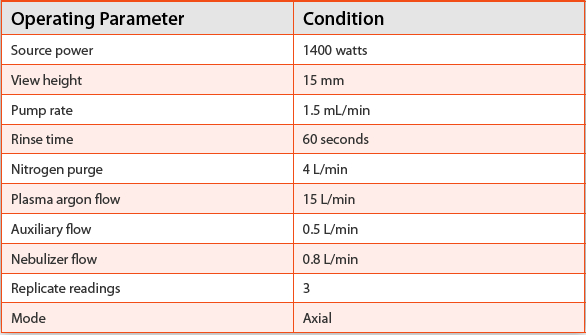
Standard Preparation
Intermediate stock solutions of 100 μg/mL of nickel, copper, zinc, iron, magnesium, tin, palladium, platinum, and ruthenium were prepared from individual standard solutions, 1000 μg/mL. Working standard solutions ranging from 0.1 μg/mL to 10 μg/mL were prepared by serial dilution of 100 μg/mL intermediate stock solution. All standards were prepared in 2% hydrochloric acid. A check standard solution was prepared at 1 μg/mL to assess the method.
The ICP-OES was set up according to the instrument parameters shown in Table 1. The primary and secondary wavelengths characteristic of each element are shown in Table 2.
Table 2. Analytes of Interest with Primary and Secondary Analytical Wavelengths for ICP-OES Analysis

Results and Discussion
The ICP-OES method was validated for 9 elements commonly used in the pharmaceutical industry (nickel, copper, zinc, iron, magnesium, tin, palladium, platinum, and ruthenium) following ICH guidelines.5-7 Specificity, linearity, repeatability, limit of detection, limit of quantitation, and system precision were evaluated as part of the generic method validation with a pre-set acceptance criterion. In addition, long-term solution stability was assessed to enable the extended use of standards. The accuracy of a generic method for new pharmaceutical compounds is evaluated during the product-specific validation and is not included in the discussions below.
Specificity
Diluent was assessed for potential spectral interference at characteristic emission wavelengths for each element. Spectral interference from a diluent blank can impact the quantitation limit of elements and occasionally result in a false positive. The results in Table 3 show that there is minimal spectral interference from the diluent blank, and the selected wavelengths are distinct for each element.
Table 3. Specificity of Blank Diluent 2% HCl

Linearity
Linearity of a method enables the determination of the dynamic range of the method. The detector response is linear within this range and hence reflective of the level present in the sample. Quantitation of elements within the dynamic range ensures the detector response is proportional to the concentration present in the sample. Linearity of the method was assessed for each element at primary and secondary wavelengths using standards ranging from 0.05 ppm to 50.0 ppm. Assessing specificity at dual wavelength provides an alternative detection wavelength in case spectral interference is observed at the primary detection wavelength. This also aids in minimizing potential false positives. Table 4 shows the results of the linearity studies. The correlation coefficients were >0.99 for all elements of interest. Based on the results, the method is linear over the concentration range of 0.05 ppm to 50.0 ppm for all elements assessed.
Table 4. Linear Regression Covering 0.05 μg/mL to 50.0 μg/mL
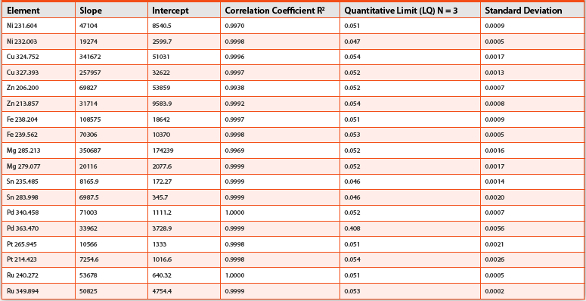
Quantitation Limits and Detection Limits
In APIs, the metallic impurities are usually present at residual levels pushing the boundaries of analytical instrumentation. For this reason, developing sensitive methods with lower detection and quantitation limits (QL) are critical in ensuring patient safety and conserving the sample especially in early stages of development.
For each of the 9 selected metals, the limit of detection (LOD) and limit of quantitation (LOQ) were evaluated based on the signal-to-noise (S/N) ratio and percent recovery. The S/N is a key attribute that helps verify the reliability of the measured signal and is that the signal is distinct from the background noise. The percent recovery is also important as it verifies the accuracy of the method at low levels. The LOD and LOQ were evaluated by testing each element of interest’s standard solution. The results for each element are shown in Table 5. The QL for each specified metal is based on the sample size used. The LOQ of the method is below 3 ppm (μg/g) for each element based on a 20-mg sample size with percent recoveries ranging from 92% to 108% for all elements, with the exception of palladium at the 363.470-nm emission line. The percent recovery of palladium at 363.470 nm is lower than 340.458 nm (82% vs 104%) and the LOQ is higher (20 ppm vs 2.6 ppm) based on the 20-mg sample, due to a lower sensitivity at 363.470 nm. However, the LOQ of palladium can be lowered if desired by increasing the sample size and by choosing an alternative emission line of 340.458 nm, which is more sensitive and specific. This emphasizes the importance of evaluating multiple lines during method development. The experimental results demonstrate the adequacy of the method for this intended use in agreement with the ICH guidelines for residual elements.
Table 5. Quantitation Limits and Detection Limits for Each Trace Element Wavelength

Repeatability and System Precision
Repeatability and precision are important parameters that should be minimally evaluated in the pharmaceutical industry. These measure the degree of closeness of analytical results between replicate measurements of a sample and between samples originating from the same homogeneous sample over a short interval of time. Repeatability adds to the adequacy of the method for its intended use.
Repeatability of the method was evaluated using triplicate standard preparations at 3 levels for each specified metal assessed. Usually, the levels bracket the nominal concentration for each specified metal. System precision was evaluated by analyzing a single preparation of the standard at a nominal concentration, usually with 6 measurements. Repeatability was assessed from the relative standard deviation (RSD) of the analytical results obtained from independent preparations of standard solution at multiple levels. Tables 6 and 7 show the results of the repeatability study. The RSD at each level and overall levels were below 20% for all samples demonstrating the adequacy of the method for intended use.
Table 6. Repeatability of 1 μg/mL (ppm) Standard Concentration on Primary Wavelength
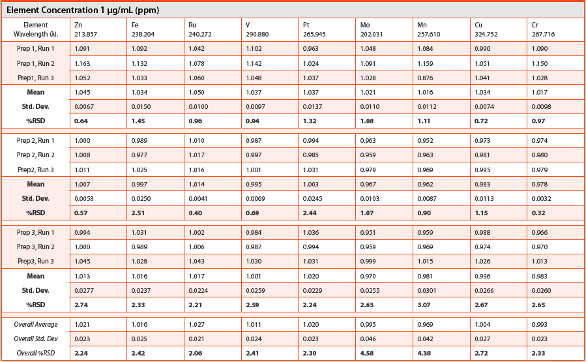
Table 7. Repeatability of 1 μg/mL (ppm) Standard Concentration on Secondary Wavelength
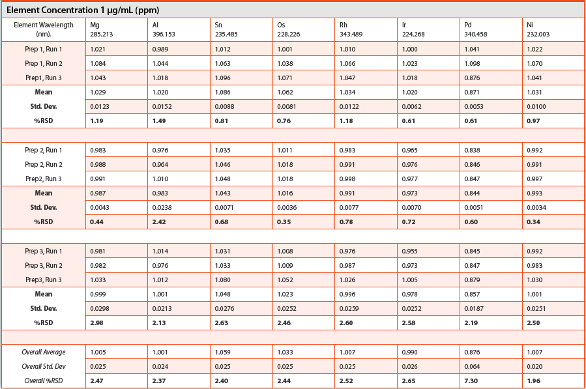
Stability of Standard Solutions
It is important to assess the stability of standard solutions used in the release testing of API as it determines the duration of its use and hence the number of samples that can be analyzed. Occasionally, it can be helpful in out-of-trend and or out-of-specification investigations. The stability of standard solution containing the elements of interest (at nominal concentration, stored at room temperature and at refrigerated conditions [2°C to 8°C]) were evaluated against a freshly prepared standard mixture over an extended period of time. The samples were tested on Days 0, 1, 4, 6, and 8 with ICP-OES and the results are summarized in Tables 8 and 9. The percent recoveries of standard solutions stored at room temperature and refrigerated conditions were within 80 to 120% with %RSD <5. The standard solutions are stable for at least 8 days (192 hours) under both storage conditions. The validation of the method demonstrated the standard solution is stable during the whole analytical procedure before and after analysis.
Table 8. Stability on Standard Solution Stored Over 8 Days at Room Temperature
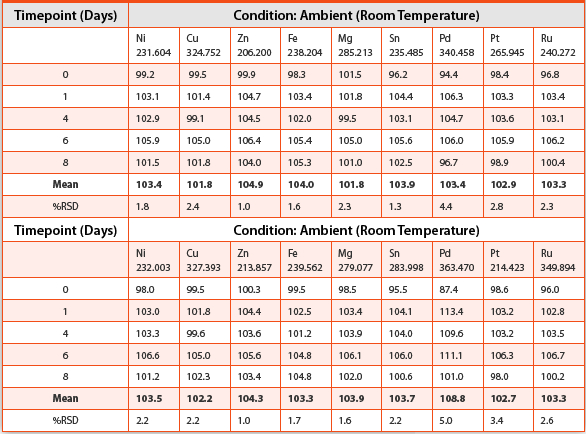
Table 9. Stability of Standard Solution Stored over 8 Days at 2°C to 8°C
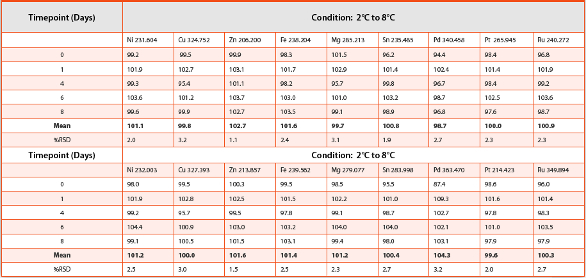
Conclusion
A generic ICP-OES method was successfully developed, optimized, and validated for trace metal analysis of 9 elements commonly used in the pharmaceutical industry. The method is suitable for projects in the early stages of development and could be extended to late stage/commercial products with minimal additional work by evaluating the robustness of the method. All acceptance criteria for the parameters evaluated were met. The generic method validation demonstrated specificity, linearity, precision, and repeatability. The QL of the method ranges from 2.3 μg/g to 20.4 μg/g based on a 20-mg sample size. The detection limit of the method ranges from 0.05 μg/g to 1.2 μg/g based on a 20-mg sample size. The accuracy of the method is evaluated for individual pharmaceutical compounds during the product-specific validation along with a specificity assessment to demonstrate a lack of matrix interference. Standard solutions are stable for at least 8 days under ambient temperatures protected from light and under refrigerated conditions. The use of a generic method has eliminated the need for a complete method validation for new compounds going forward, resulting in significant savings. The generic platform technologies discussed above can be a practical approach to quickly support the early phases of drug development. Generic platform technologies can enhance efficiencies and eliminate redundancy in method validation for similar sample matrices. Practical generic procedures can support multiple products in development in the clinical pipeline.
References
- The United States Pharmacopeia Convention: Draft <232> and <233>, Pharmacopeia Forum 36(1), 2010.
- International Conference on Harmonization of Technical Requirements for Registration of Pharmaceuticals for Human Use, Guideline for Elemental Impurities Q3D, step 2b version, 26 July 2013.
- Boss CB, Fredeen KJ. Concepts, Instrumentation and Techniques in Inductively Coupled Plasma Optical Emission Spectrometry. Shelton, CT: PerkinElmer; 2004.
- Patel I, Venkatramani CJ, Mistry K. Enhancing efficiency of trace metals analysis using generic method validation by ICP-OES. Pittcon. Atlanta, GA. 2011.
- EMEA/CHMP/SWP/4446/2000, Guideline on the specification limits for residues of metal catalysts or metal reagents. Committee for Medicinal Products for Human Use (CHMP). London; 21 February 2008.
- ICH Harmonized Tripartite Guideline. Q6A—Specifications: Test Procedures and Acceptance Criteria for New Drug Substances and New Drug Products: Chemical Substances, Step 4 Version, 06 October 1999.
- The United States Pharmacopeia Convention: General chapter <1225>, Validation of compendia procedure, Rockville, MD; 2009.
Author Biographies
Ila Patel is a Sr. Research Associate in Small Molecule Pharmaceutical Sciences Department at Genentech, USA. She has over 15 years of experience in the pharmaceutical industry supporting early stage drug development in small molecules to large molecule commercial projects. Her specialization/expertise is in a wide range of spectroscopic techniques for elemental analysis by AA, ICP-OES, and ICP-MS.
C.J. Venkatramani is a senior scientist at Genentech, USA and has over 15 years of experience in the pharmaceutical industry. He was the key member of the Genentech technical team instrumental in taking gRED’s first small molecule Erivedge from development to commercial. Erivedge is currently approved in several countries around the world for the treatment of advanced BCC. His areas of interests include ultra-trace analysis and multi-dimensional chromatography.
Larry Wigman is an analytical chemist by training with his doctorate from Duke University, under the direction of the late Charles Lochmuller. Larry has held various positions including: Senior Research Scientist at Pfizer, Manager at Mylan, Associate Director at Sanofi, Principal Consultant at Regulitics LLC; and, is currently Senior Scientific Manager of the Small Molecule Analytical Chemistry and Quality Control (SMACQC) Department at Genentech.